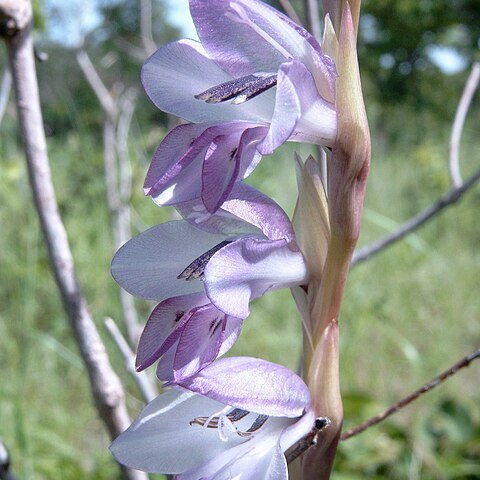Flowers usually light-to dark-purple (dark-reddish brown) fading to cream-coloured in the throat or mostly white, the tube usually dark-purple below, the lower tepals each with a dark-purple diamond-shaped mark in the distal third; perianth tube c. 12 mm long, curving outward and widening above; tepals unequal, the uppermost (16)22–26 × 12–18 mm, arched over the stamens, the lower 3 tepals c. 12 × c. 5 mm, usually shortly exceeding the uppermost when viewed in profile, narrowed below into claws, the limbs flexed downward and channelled, joined to the upper lateral tepals for 4–6 mm and to one another for c. 2 mm.
Spike (2)8–20(25)-flowered, erect, often congested, evidently straight but flexuous under the bracts; bracts 20–30(50) × 8–10 mm at the widest, green or becoming dry and brown at the end of flowering, firm, sometimes slightly striate (the veins raised and hyaline), imbricate, 2–2.5(3) internodes long, the inner c. two-thirds as long as the outer.
A slender herb. It keeps growing from year to year. It grows 30-80 cm tall. The corm is fibrous. It is 2-3 cm across. There are 4-7 leaves at the base. The leaves on the stem are shorter. The flower spike has 8-20 flowers. They are green. There are overlapping flower bracts along the stem. The fruit is a narrow capsule 12-15 mm long.
Foliage leaves 4–7, the lower 3–5 more or less basal, half to two thirds as long as the stem and (6)9–16(24) mm wide, narrowly lanceolate, the margins and midribs not or hardly thickened; upper leaves cauline and shorter.
Corms (12)18–30(40) mm in diameter; tunics membranous, fragmenting irregularly, occasionally subfibrous and the fibres then somewhat clawed.
Style dividing opposite the lower half of the anthers, style branches c. 2 mm long.
Capsules 12–15 mm long, narrowly ellipsoid, fairly hard and woody.
Filaments 9–13 mm long, exserted 5–6 mm; anthers 7–10 mm long.
Flowers purple or white with purple throat.
A slender herb with very narrow leaves
Stem erect and straight, unbranched.
Plants (15)30–80 cm high.

